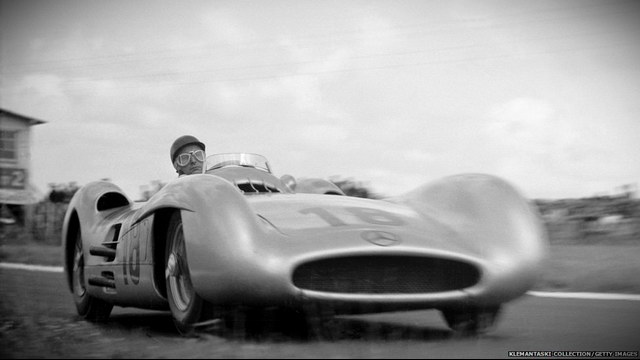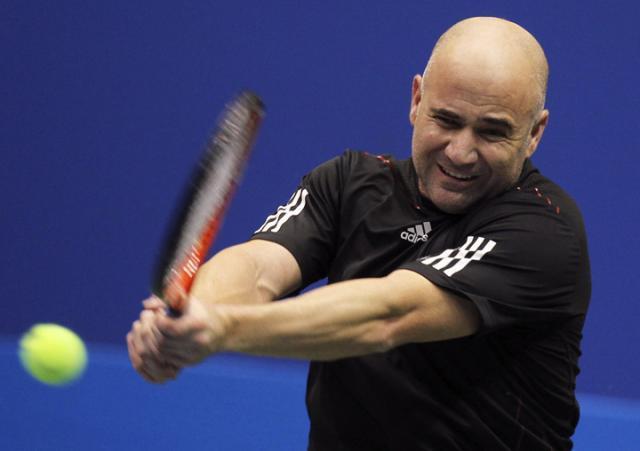CMC歷年推出的各款W196R (轉文)

我前幾天拜讀完MC論壇Lee兄關於CMC W196R的美文後,才對這個50年代F1的系列有了個大概的了解。另外就是原來最值得收藏的號碼是Fangio的#2、#18,還有就是隊友Moss第一次在本土英國奪冠的#12號。
以下是CMC出過所有的W196車款:

W196 這部車和歷史大家都很了解了,這里更多的是想分享些自己的理解。其中有些觀點和之前的帖子有些出入,希望和大家切磋討論。
1. 首先聊聊車名,我們都習慣于CMC的命名方式。流線型(streamlined)的16,18號叫W196R。其他輪子露在外面(open-wheel)的叫W196。我認為這是不恰當的。我查到主流的兩种說法是:
A. 維基百科:以上兩种車型都叫W196,只是用streamlined和open-wheel加以區分。
B. 奔馳官方和權威書籍:兩种車型都叫W196R,而是用streamlined和monoposto來區分。我個人認為奔馳官方說法更准确。因此推斷CMC早年將monoposto錯誤的命名為W196,在后來出streamlined的時候注意到了這個問題,于是在W196后面加上了R改正了這個錯誤。因此,根据奔馳官方命名方式,以下我統稱W196R(包括streamlined和monoposto)。
關于W196R的和W196定義的界定,今天終于在《Silver Arrows in Camera 1951-55》得到了准确的答案:1954年Mercedes-Benz Grand Prix賽車的工厂命名是196R(其中R代表Renne),而運動型的版本(常被稱為300SLR)的工厂命名是W196S(其中S代表Sport)。同時,工厂稱流線型、輪子外漏的W196R為monoposto,用以區分首次亮相的W196R的流線型。
2. 接著我們了解一下這兩种車型參加的比賽。我看到不少帖子里說streamlined只參加了55年最后一站的Monza。這個說法是不正确的。事實恰恰相反:streamlined才是W196R最初的設計,并且在54年法國大獎賽的Reims-Gueux高速賽道中第一次露面就拿到了冠亞軍(Fangio 和 Karl Kling)。但同樣的車型在隨后的Silverstone賽道卻大失水准。其原因就是那樣的外形不夠靈活不适合彎道太多的賽道。因此在接下來的Nurburgring,W196R被改造成傳統的open-wheel(monoposto)樣式,Fangio駕駛著它拿到了冠軍。從此奔馳更多是使用monoposto車型參加接下來的比賽,只有54和55年意大利的高速賽道Monza才會用到streamlined(當然monoposto也同場競技)。
3. 以下我們來談談CMC出過的所有W196R的車型及其歷史:
M-019 W196R monoposto #2: 55年阿根廷站Fangio的冠軍車。這場比賽雖然只有一輛W196R拿到了前三。但是其過程及其艱辛,下面會有詳細講解。
M-020 W196R monoposto #6: 55年阿根廷站Moss的車。看到壇子里有朋友有這部車。但很可惜的是它并沒有拿到名次,中途因供油系統故障而退賽。
M-021 W196R monoposto #8: 55年阿根廷站Hans Herrmann的車,在Moss和Karl Kling相繼退賽后,三人共同駕駛拿到了第四名,積分三人平分各得到一分。
M-041 W196R monoposto #10: 55年英國站Fangio的亞軍車。這一場比賽是W196R最輝煌的一場比賽,拿到1-2-3-4。
M-042 W196R monoposto #12: 55年英國站Moss的冠軍車。這是Moss的個人第一個冠軍,也是英國車手第一次在自家門口奪冠。但Moss賽后曾表示,最后和自己几乎同時沖線的Fangio完全是有机會超過他的,Fangio沒有這么做應該是想把這個冠軍讓給他的年輕隊友,不僅因為這站的冠軍對Moss的意義重大,更想因此激勵和鼓舞這個年輕而有天賦的隊友。
M-049 W196R streamlined #18: 大家對這部車都很熟悉了。55年最后一站Monza賽道Fangio駕駛的冠軍車。此后銀箭离開了F1 56年。值得注意的是這輛18號是54年法國站的18號的改進型,外形有所變化。
M-057 W196R streamlined #16: 55年Monza賽道Moss駕駛的車。很遺憾,它也沒能完成比賽,因發動机故障而退賽。
Juan Manuel Fangio Formula 1′s first legend
3 July, 2011
Jul.3 (Mercedes) Juan Manuel Fangio would have turned 100 years old on 24 June 2011. Mercedes pay tribute to one of the greatest Formula 1 race drivers of all time on the advent of this anniversary occasion.
Racing driver Juan Manuel Fangio was the leading figure in Mercedes-Benz’s campaign to win the Formula 1 World Championship in the 1954 and 1955 seasons. Fangio formed an almost symbiotic partnership with the W 196 R racing car: “It’s the perfect car. The machine which every driver dreams about their whole life long,” he once said of the Silver Arrow.
Fangio drove to a total of five Formula 1 world titles in vehicles from four different manufacturers. There was something very special about his relationship with Mercedes-Benz though. He had already been working as a dealer for the Stuttgart-based brand in Argentina since 1951. And following the end of his racing career, he became President of Mercedes-Benz Argentina S.A. in 1974.
He died in Buenos Aires on 17 July 1995.
It was at the French Grand Prix on 4 July 1954 that Mercedes-Benz made its first ever appearance with the new Silver Arrows from the W 196 R series. The victor at the Reims circuit was Juan Manuel Fangio, who had been world champion in 1951 and finished second in 1950 and 1953. The Argentinean was already aged 43 at the time, making him older than many of the other drivers in the field. He had furthermore suffered a serious accident in the 1952 season.
Yet far from being a fabulous finale to his career, Fangio’s win for Mercedes-Benz at the wheel of the W 196 R marked the start of an extraordinary success story. During 1954 and 1955, Fangio lined up on the starting grid for the Mercedes-Benz team for a total of 19 Formula 1 and touring car races, recording ten wins and a number of other impressive results.
Fangio was born to Italian immigrants on 24 June 1911 in the small country town of Balcarce in Argentina – seemingly a very far cry from a future career as a five-time Formula 1 world champion. But the youngster, who did an apprenticeship as a mechanic, was inspired by his fellow countrymen’s passion for motor racing.
He came into contact with the local racing driver scene at an early age, gained some experience at the wheel himself and learned how to rebuild vehicles for racing. In 1932, he opened his own car workshop, and four years later Fangio competed in his first race in a converted Ford taxi.
After the end of World War II, Fangio made the switch from rebuilt standard passenger cars to thoroughbred racing cars, and entered the international racing arena. In 1950, he came second in the World Championship driving for Alfa Romeo, before going on to win his first world title for the Italian car maker in 1951. 1951 also marked the start of Fangio’s close ties with Mercedes-Benz, however, as it was the year he opened a sales outlet for the Stuttgart brand’s cars in Buenos Aires.
And it was not long before he was sitting behind the wheel of a Silver Arrow for the first time; in February 1951, Mercedes-Benz came over to Argentina, bringing with it three overhauled pre-war W 154 racing cars for a guest race appearance. Fangio was on the starting grid for the “Premio Presidente de la Nación Juan D. Perón”, along with Karl Kling and Hermann Lang. However, the Silver Arrows were unable to reach their top speed on the modern circuit with its many chicanes, and Fangio only managed to finish third.
During the 1952 season, when the World Championship was switched to Formula 2, Fangio suffered a serious accident in Monza. He spent the remainder of the year convalescing from his injuries, most notably from one he sustained to his spine. He was already back in the racing seat in 1953 though, when he finished second in the World Championship with Maserati.
International motor racing was made all the more spectacular in 1954 by the return of Mercedes-Benz to the grand prix arena. Racing director Alfred Neubauer signed the Argentinean driving ace as the captain of the racing team.
The Stuttgart-based outfit had been developing the W 196 R racing car for the new Formula 1 season since 1953. It was powered by a 257 hp (189 kW) inline eight-cylinder engine with a displacement of 2.5 litres, desmodromic valves and direct petrol injection.
Apart from the Streamliner version, a classic Formula racing car with exposed wheels was also created. The new Silver Arrows were not ready for the start of the season, so Fangio still competed in a Maserati in the first three races. At that time, the Formula 1 World Championship consisted of just a drivers’ title. The constructors’ championship was only contested from the 1958 season onwards.
On 4 July 1954, Fangio lined up for his first ever grand prix in a Mercedes-Benz: exactly 40 years after Mercedes driver Christian Lautenschlager drove to victory in Lyon, the Stuttgart team returned to the fray at the French Grand Prix in Reims. Fangio took the chequered flag ahead of teammate Karl Kling.
The apparently effortless switch from Maserati to the W 196 R once again underlined Fangio’s immense ability to adapt: ever since taking part in the tough endurance races in his home country, he seemed to be able to extract the very best from every vehicle. It was this virtuoso improvisational skill that led to victory for the Argentinean time and time again.
The 1954 season turned into a great triumph for Mercedes-Benz and Fangio: he followed up his victory in France with further wins in Germany (Nürburgring), Switzerland (Bremgarten) and Italy (Monza). Fangio was crowned Formula 1 world champion for the second time, with almost double the points of his nearest rival.
The Argentinean dominated the 1955 season in similar fashion, winning the grand prix races in Argentina, Belgium, the Netherlands and Italy, and finishing second behind teammate Stirling Moss at the British Grand Prix.
Other exceptional performances by Fangio during this season included second spot at the Mille Miglia, driving solo in a Mercedes-Benz 300 SLR (W 196 S). Winner Stirling Moss, on the other hand, was accompanied by a co-driver, Denis Jenkinson, as was most of the field.
Following Mercedes-Benz’s withdrawal from motor racing at the end of the 1955 season, Fangio went on to win two more world championship titles with Ferrari (1956) and Maserati (1957). The following year, the Argentinean called an end to his racing career at the age of 47.
In 1974, he assumed the post of President of Mercedes-Benz Argentina S.A. His five Formula 1 world championship titles remained a record until his death in 1995, which was not surpassed until Michael Schumacher achieved the feat in 2003.
Today, tributes to Juan Manuel Fangio include five identical life-size bronze sculptures depicting the exceptional racing driver together with the W 196 R. They can be found in front of the Mercedes-Benz Museum in Stuttgart, outside the Mercedes-Benz headquarters in Buenos Aires, as well as at the Nürburgring, Monza and Monaco circuits.
There is also a Fangio Museum in Balcarce that is run by a local association. Featuring numerous vehicles and other exhibits, it is dedicated to the racing driver’s whole life story.
Juan Manuel Fangio’s races for Mercedes-Benz
|
Date
|
Race
|
Vehicle
|
Placed
|
|
17.2.1951
|
Gran Premio Presidente de la Nación Juan D. Perón (Circuito Costanera Norte, Buenos Aires)
|
W 163
|
3rd
|
|
24.2.1951
|
Gran Premio Maria Eva Duarte de Perón (Buenos Aires)
|
W 163
|
DNF*
|
|
4.7.1954
|
French Grand Prix (Reims)
|
W 196 R Streamliner
|
1st
|
|
17.7.1954
|
British Grand Prix (Silverstone)
|
W 196 R Streamliner
|
4th
|
|
1.8.1954
|
European Grand Prix (Nürburgring)
|
W 196 R exposed wheels
|
1st
|
|
22.8.1954
|
Swiss Grand Prix (Bern)
|
W 196 R exposed wheels
|
1st
|
|
5.9.1954
|
Italian Grand Prix (Monza)
|
W 196 R Streamliner
|
1st
|
|
19.9.1954
|
AVUS Race (Berlin)
|
W 196 R Streamliner
|
2nd
|
|
24.10.1954
|
Spanish Grand Prix (Barcelona)
|
W 196 R exposed wheels
|
3rd
|
|
16.1.1955
|
Argentinean Grand Prix (Buenos Aires)
|
W 196 R
|
1st
|
|
30.1.1955
|
Buenos Aires Grand Prix
|
W 196 R with 3-litre engine
|
1st
|
|
1.5.1955
|
Mille Miglia
|
300 SLR
|
2nd
|
|
22.5.1955
|
European Grand Prix (Monaco)
|
W 196 R exposed wheels
|
DNF*
|
|
29.5.1955
|
Eifel Race (Nürburgring)
|
300 SLR
|
1st
|
|
5.6.1955
|
Belgian Grand Prix (Spa-Francorchamps)
|
W 196 R exposed wheels
|
1st
|
|
11.-12.6.1955
|
Le Mans 24 Hours
|
300 SLR
|
RET**
|
|
19.6.1955
|
Dutch Grand Prix (Zandvoort)
|
W 196 R exposed wheels
|
1st
|
|
16.7.1955
|
British Grand Prix (Aintree)
|
W 196 R exposed wheels
|
2nd
|
|
7.8.1955
|
Swedish Grand Prix (Kristianstad)
|
300 SLR
|
1st
|
|
11.9.1955
|
Italian Grand Prix (Monza)
|
W 196 R Streamliner
|
1st
|
|
17.9.1955
|
Tourist Trophy (Dundrod)
|
300 SLR with Karl Kling
|
2nd
|
|
16.10.1955
|
Targa Florio (Sicily)
|
300 SLR with Karl Kling
|
2nd
|
** RET = Retired
